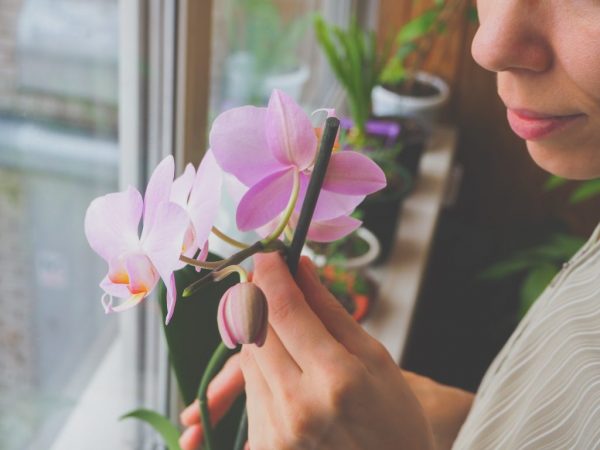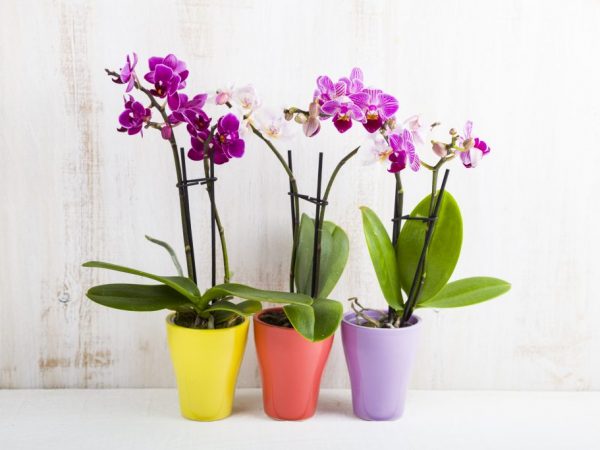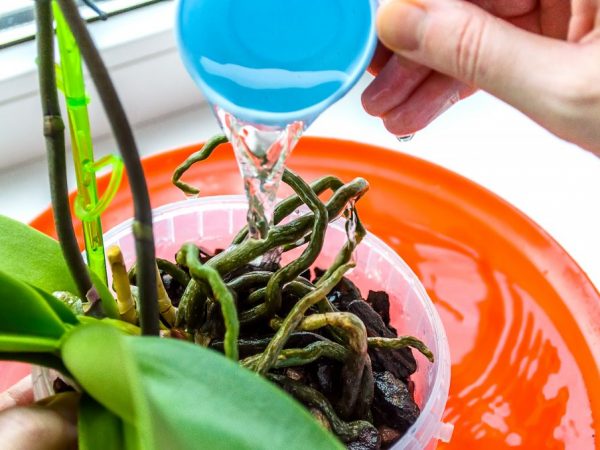What to do with white bloom on orchids
Indoor phalaenopsis have long become habitual inhabitants of houses. The plant pleases with long and abundant flowering, therefore it enjoys the love of flower growers. White bloom on orchid leaves indicates a serious disease of the flower.

What to do with white bloom on orchids
Plaque causes
White bloom on orchids is a phenomenon, the main cause of which is powdery mildew.
Outwardly, the problem manifests itself as follows: first the leaves from the back are covered with an opaque film, then the mold affects the roots. Over time, the substrate and the walls of the pot are covered with a white and indelible bloom.
This phenomenon is caused by the following pests:
- mealybug;
- aphid;
- spider mite.
The cause of the disease can be the wrong conditions of the plant, as well as the varietal predisposition of the flower to the disease.

Powdery mildew causes white bloom
The most common mistakes made by florists, which result in white spots on phalaenopsis:
- too low humidity and air temperature in the room;
- stagnant water in a pot;
- frostbite of the leaves, caused by a draft;
- coldness coming from glass in autumn and winter.
Treatment methods
If white patches appear on orchid leaves, targeted chemicals and home remedies for mildew and white patches on orchid leaves can help get rid of it.
The process of dealing with the manifestations of the disease on phalaenopsis is:
- drying the soil in a pot;
- treatment with anti-aphid substances;
- creating the right conditions for the plant.
Home remedies
Home remedies can help get rid of disease on leaves and roots. Life-saving drugs are:
- ethyl medical alcohol 96%;
- hydrogen peroxide;
- ammonia.
Potassium permanganate is also useful. Phalaenopsis are treated for the disease in the following order:
- Drain the soil in a pot with a diseased flower.
- Phalaenopsis leaves are treated with any potent substance. To do this, alcohol, ammonia or peroxide is applied to a cotton pad, then they wipe the places where powdery mildew appears.
- Phalaenopsis is left indoors for half an hour. During this time, pests will die under the influence of the listed substances.
- The pot is transferred to the bathroom and then the leaves are rinsed under the shower. The water should be at room temperature. To enhance the effect, leaves covered with white bloom are poured from a watering can.

Home Remedies Help Get Rid of Disease on Leaves and Roots
Baking soda or citric acid is sometimes used as a septic tank. These substances are dissolved in water at the rate of 10 g per 1 liter of water, then the leaves are wiped with this solution as soon as white spots appear on them. Rehabilitation of the soil with a light solution of potassium permanganate also allows you to get rid of the disease on the roots of the flower.
After processing, the flowers are transferred to a warm room, protected from temperature changes and drafts. Excessive waterlogging of the substrate is also avoided.
Chemicals
The best chemical agents to get rid of white bloom and spots on a tropical flower are bactericidal, fungicidal or complex agents, among which are:
- Fitosporin. A universal drug that can get rid of diseases of a bacterial or fungal nature.
- Bordeaux mixture. A composition of copper sulfate and lime, the action of which is manifested in the fight against bacteria and foliar feeding.
- "Quadris". A broad-spectrum drug based on azoxystrobin, which has a therapeutic effect. It is used for preventive treatments.
- "Pure color". The drug, developed specifically for indoor plants, which, in addition to therapeutic treatment, has proven itself well for prophylactic purposes. It is used when spots on the phalaenopsis only appear.

Chemicals help get rid of white patches
All of the listed substances are used in accordance with the attached instructions. After processing flowers from powdery mildew, hands and equipment are washed with soap in order to avoid poisoning with the contents of the phalaenopsis treatment products. It is also advisable to carry out processing outside the living quarters: on the balcony, in the yard or in the bathroom.
Prophylaxis
To prevent the appearance of white bloom on the leaves of felinopsis, special granules are used. They are purchased at flower shops. The agent is placed in the ground during transplantation. Opt for granules for orchids.
As a preventive measure for plaque, the plant is placed on a western well-lit window. Air humidity should not fall below 70%.
Conclusion
Phalaenopsis are not quite ordinary indoor flowers. They are distinguished by their fastidiousness in the conditions of detention and demanding care. Tropical flowers breathe with roots, so a porous and light soil is needed for planting.
The slightest discrepancy to the conditions of detention, and the phalaenopsis will wither away. That is why it is necessary to deal with white spots on the leaves and other parts of phalaenopsis urgently, otherwise there is a risk of damage to the root system of the flower.


